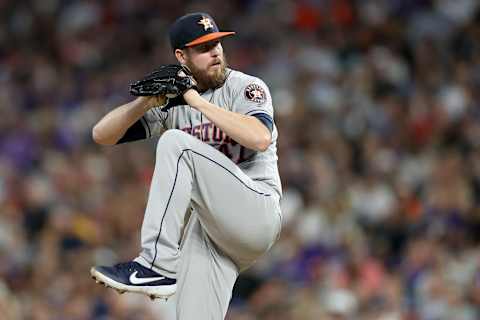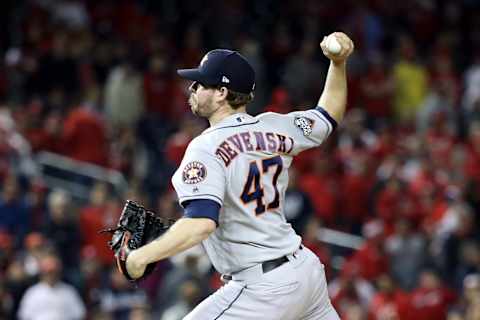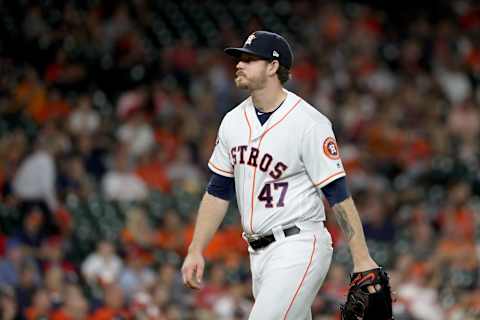Astros: Could Chris Devenski regain his All-Star form?

Could Houston Astros pitcher Chris Devenski regain his All-Star form now that he’s back on the roster?
We’ve been hearing about Chris Devenski’s impending return for a while, it seems, and now it has finally happened. The Houston Astros activated Devenski from the Injured List in advance of Friday’s game and optioned struggling reliever Joe Biagini to the alternate site.
Devenski has not pitched since allowing three runs in one inning on July 26, which was just his second outing of the season. The Astros placed him on the IL with elbow soreness and he has spent the past few weeks rehabbing at the team’s alternate site in Corpus Christi.
In his season debut on July 24, Devenski struck out three and allowed one hit in a scoreless inning, so perhaps the elbow troubles played a role in his bad outing two days later. We’ll see what the 29-year-old has in store coming off a pair of disappointing seasons in 2018 and 2019.
The obvious question remains, of course, whether he can recapture the success he found in 2016 and 2017 that made him an All-Star and a Rookie of the Year candidate. To answer that question, let’s take a dive into the advanced stats courtesy of Baseball Savant and Baseball-Reference.

What the Numbers Say
At first glance, 2016 and 2017 were clearly his best years, with a quick decline in 2018 and an even further slide in the wrong direction for 2019. His ERA and WHIP climbed every season in that span, so it seems like things have just been on a constant downhill slide.
But let’s look a little deeper. Devenski’s 2016 season, in which he posted a 2.16 ERA in 108.1 innings, is probably an outlier. He was helped by a career-low walk rate and an abnormally low home run rate, only allowing four homers all season. That rate is far below the rest of his seasons, including his All-Star 2017. So in that sense, expecting him to replicate 2016 would be unfair.
He actually had a career-high walk rate in 2017 but a career-low hit rate, and his 1.2 home runs allowed per nine innings is more of a reasonable expectation. He benefited from a career-best strikeout rate that year as well and managed a 2.68 ERA in 80.2 innings.
For 2018 and 2019, his walk rate stayed close to the same, and his strikeout rate went down slightly but was still plenty healthy. The main difference is his rates of allowing hits and homers took a jump, with his 1.7 homers allowed per nine innings being a little higher than one would like. That, coupled with the fact that he was simply allowing more hits overall, caused his ERA to jump north of 4.00 in each of those seasons.

The Arsenal
We’ll go pitch-by-pitch through his arsenal, and he’s thrown his four-seamer more than 40 percent of the time over the course of his career. His velocity actually increased in every season from 2016 to 2019, topping out at 94.7 mph last year. Yet in spite of that, the pitch’s effectiveness decreased.
Batters hit .211 and slugged .422 off the fastball in 2017, but those numbers jumped to .295 and .551 in 2018, respectively. It was worse in 2019, as batters teed off to the tune of a .306 average and .587 slugging off the four-seamer, and remember that’s in spite of increased velocity. Batters’ exit velocity off the pitch was also higher in 2018 and 2019.
But the increased velocity has coincided with decreased lateral movement. The horizontal movement on his four-seamer has gone down every year since 2017, so the pitch may have gained a little velocity, but it’s lost a little movement. Straighter and harder isn’t necessarily the way to go unless you’re throwing triple digits and can really blow it by people.
The changeup, which he uses between 30 and 40 percent of the time, is his best weapon. Batters hit only .145 off it in 2017 and .175 in 2018. They hit a career-high .208 off it in 2019, which still makes it an effective pitch, though not quite as dominant as in previous years. The average exit velocity and home runs allowed off the pitch weren’t abnormally high either.
From a movement standpoint, the horizontal movement hasn’t gone down, but the vertical movement took a slight dip in 2019. That seems to have corrected itself in the earlygoing in 2020, but it’s something to keep an eye on. Either way, I wouldn’t worry too much about the changeup.
Then there’s the slider, which he’s thrown around 20 percent of the time. It was most effective in 2016 when batters hit .079 off of it, but that number has gone up to .178, then to .250 in 2018 and .233 in 2019. The movement on the pitch has actually gotten better, though the velocity has gone down just a little. Since 2017, batters’ exit velocities have steadily gone down, so this doesn’t seem to be a problem pitch either.

The Results
Since 2017, Devenski’s groundball rate has gone down every year while his flyball rate has increased. His line drive rate the past two years was also higher than 2017. Hitters were generally doing a better job of getting underneath the ball, which makes sense given the shifting flyball/groundball splits.
Batters definitely barreled up the ball more frequently against him in 2019, and they whiffed on his pitches at a career-low rate as well. It’s interesting because he actually had a career-best first pitch strike percentage. But hitters made contact on pitches both in the zone and outside the zone more frequently than in any other season in his career.
It makes sense when you think about how his pitches changed. When your fastball is a little straighter and your changeup doesn’t dive quite as much, hitters aren’t going to miss them as often. The changes to the pitches aren’t huge, but there’s not much margin for error in this game. The smallest thing can make the difference between a home run and a flyout.
If you’re thinking he’s leaving more pitches over the plate, you might be surprised. The percentage of his pitches that would be described as a “meatball” pitch (i.e. right over the middle of the plate) actually peaked in 2017 and was lower in 2018 and 2019. So Devenski’s problem doesn’t appear to be control-related, at least not to a large extent.
You also have to look at the context. The 2019 season was an outlier for the league in terms of home runs, with an abnormally large number of them hit, at least partially due to a change in the baseballs. At times, it seemed like all a hitter had to do was get the barrel to the ball and get it in the air and he’d have a home run. That surely couldn’t have helped Devenski either.

What to Expect Going Forward
I’ve already said I don’t think it’s reasonable for fans to think he’ll revert to his 2016 form simply because there seemed to be so many outliers in his numbers that year. His 2017 season would be a more realistic target, but even then I don’t think that would necessarily be fair. Things have changed since then.
For one, Devenski now has more of a history around the league, which means hitters have more to study. They can get a better sense of his tendencies and ways to pick up his pitches, so he may simply not be the utterly dominant force he was in his first couple of seasons.
More from Climbing Tal's Hill
- Just how much better is the Houston Astros playoff rotation than the rest?
- Houston Astros: A Lineup Change to Spark Offense
- Astros prospect Hunter Brown throws 6 shutout innings in debut
- Always faithful Astros World Series champion Josh Reddick defends the title
- Michael Conforto declines Astros’ 2-year, $30 million offer
But there’s certainly some room for improvement, and I think he should be able to settle in as a solid middle reliever with an ERA in the low-to-mid threes. To do that, perhaps the biggest thing that’ll help is to find that extra bit of movement on his fastball and changeup that was lacking in 2019. Hopefully pitching coach Brent Strom can help with that.
Consistency will be key as well. Over the past couple of years there have been outings where he’s looked flat out untouchable, and there have also been outings where he got hit pretty hard. Every pitcher has a rough night every so often, so it’s a matter of having as few of those as possible. Easier said than done, I know.
But the key in his overall numbers isn’t walks or strikeouts — it’s hits and home runs. Whatever he can do to cut down on those will help him out the most. He still has the stuff to get hitters out and be an important piece of the Astros bullpen, and these last few weeks of the season will be key as he tries to reestablish himself as one of the team’s best relievers.